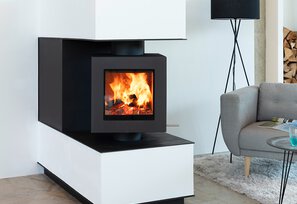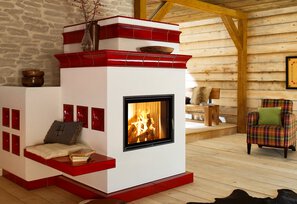Heating with wood: the right way to do it
There is nothing more beautiful than the wonderful play of flames on cold evenings. However, if you want to protect the environment, you should heat properly. This is the only way to keep emission rates and health hazards low.
Heating completely without emissions is not possible. Combustion products such as carbon monoxide or dioxide are always produced. However, with the correct kindling, start-up and heating as well as the right fuel (dry wood), the pollution can be reduced considerably. The correct combustion air setting also plays a major role in heating with wood.
In addition, the heating instructions of the respective manufacturer must always be observed; our following tips are only of general information value.

Before heating is after heating
A clean and technically perfect fireplace is the be-all and end-all for low-emission heating. The chimney must also be suitable. For this reason, every installed system is regularly checked by the chimney sweep.
In principle, two types of kindling can be distinguished: Kindling from above and ignition from below. Each of these types of kindling supports certain types of firing. Thus, kindling from above is recommended for grate-less firings, while kindling from below should be used when a floor grate is present.
Proper kindling requires:
Natural kindling aids such as the Fidibus from Brunner
Wood logs with a circumference of less than 20 cm
Caution: Never use flammable liquids such as petroleum or spirit (risk of deflagration), plastics of any kind, waste, scrap wood, treated wood, plywood, fibreboard, glued wood, bark briquettes or chipboard. Painted, coated or varnished wood is also taboo.
Correct kindling with environmental awareness
The correct kindling helps with an environmentally conscious heating, a quick heat gain and a long heating enjoyment.
LIGHTING FROM ABOVE IN RUSTLESS FIRES
Place two to three logs side by side on the floor of the firebox with a small space between them (the edges of the logs should point upwards)
Position the matches crosswise on the logs
Place the Brunner Fidibus fireplace lighters (3 cm - 5 cm apart) between the matches.
Adjust the air slide according to the operating instructions
Check that the butterfly valves and gate valves are open
Light the matches and close the door of the firebox
Kindling from below with an existing floor grate
Place kindling materials on the open bottom grate
Position kindling between the kindling logs
Stack layers of kindling logs on top
Place 2-3 less thick logs on top of the kindling logs ( split edge downwards)
Adjust air slide according to the operating instructions
Check, that the butterfly valves and shut-off grilles are open
Light the igniter and close the firebox door
Correct reheating
When heating correctly, the air supply is reduced when the flames have ignited the wood. The logs are not added until there are embers. To continue heating, the new logs are placed on the base embers; wood briquettes can also be used as an option.
The embers should be pushed together to form a compact bed of embers before new wood is added. To achieve rapid over-ignition of the wood, it helps to open the air slide further. This is the point at which the combustion air supply should be reduced to normal operation. On some models, additional adjustments must be made to the floor grate. These settings can be found in the operating instructions.
Note: The heating process can be repeated as often as desired. The amount of fuel varies depending on the device. For correct heating, it is advisable to use the quantity approved and tested by the manufacturer.
If the heating operation is to be terminated, no more wood must be added and the combustion air supply is closed after the residual embers have cooled down. This prevents the room where the stove is installed from cooling down.

Proper wood storage
When heating with wood, the type of wood and its correct storage determine whether it burns properly in the fireplace. It has been common practice for centuries to stack logs in such a way that space is saved. The height of the stack depends on the shape and size of the logs.
It is important to store the firewood in a dry and well-ventilated place, as damp wood burns very badly, gives off little heat but causes a lot of smoke. The drier the wood, the higher the calorific value. The chimney sweep usually measures the moisture content of the wood with a wood moisture meter during his inspections.
Ideal storage places are dry, roofed and well-ventilated shelters that have a protected floor so that the soil moisture cannot rise. The perfect storage place is therefore a shed - as long as the wood is already well dried. If the wood is still damp, it should be stored outdoors, as drying takes place more quickly here. Unsuitable are closed rooms such as cellars or wood piles that have been wrapped in foil.
In Germany, it is sufficient to let the wood dry for one summer under favourable storage conditions. During this time, the moisture content of the wood is usually below 20 %.
Storing wood properly:
Preferably store the wood against a wall, e.g. a house wall. Make sure there is a distance of approx. 10 cm so that the air can circulate. This will speed up the drying of the wood.
Inside the stack, place the logs so that the wind can pass through. The base is formed by thin logs that are laid across the direction in which the logs are stored. This way the wood has enough distance to the ground and thus to the soil moisture.
More details on this in our article " Laying out wood stocks professionally" .

These wood species are suitable for firewood
The choice of the right firewood is decisive for the heating value. Properties such as flying sparks, the colour of the flames and the scent are often decisive in the choice of wood.
Suitable are:
Beech (highest calorific value)
Maple
Cherry
Ash
Hornbeam (but difficult to split)
Softwoods such as alder, poplar and willow are less suitable as they leave a high ash content. Softwoods such as larch, pine or spruce are less suitable for open fireplaces as they have a very high spark. However, this can also be remedied with an appropriate spark screen.

Conclusion
The correct lighting of a wood fire needs to be learned. Not only the right technique but also the right fuel are crucial for a successful lighting process. There is a large selection of firewoods and the choice can influence the heating value as well as the flying sparks, the colour of the flames and the scent.
The Fidibus by Brunner is an optimal kindling aid. It consists of pure wood fibres with natural paraffin, does not smell, does not dry out and is absolutely harmless to health.












